Key takeaways:
- Fake emails, or phishing attempts, mimic legitimate communications to trick users into revealing personal information; common signs include poor grammar and generic greetings.
- Effective consumer protection builds trust in online transactions, empowering consumers to assert their rights and ensuring a fair market.
- Techniques for spotting fake emails include examining sender addresses, identifying urgent language, and checking links before clicking.
- Reporting fake emails to providers and using email verification tools are crucial steps in preventing scams and protecting others from fraud.
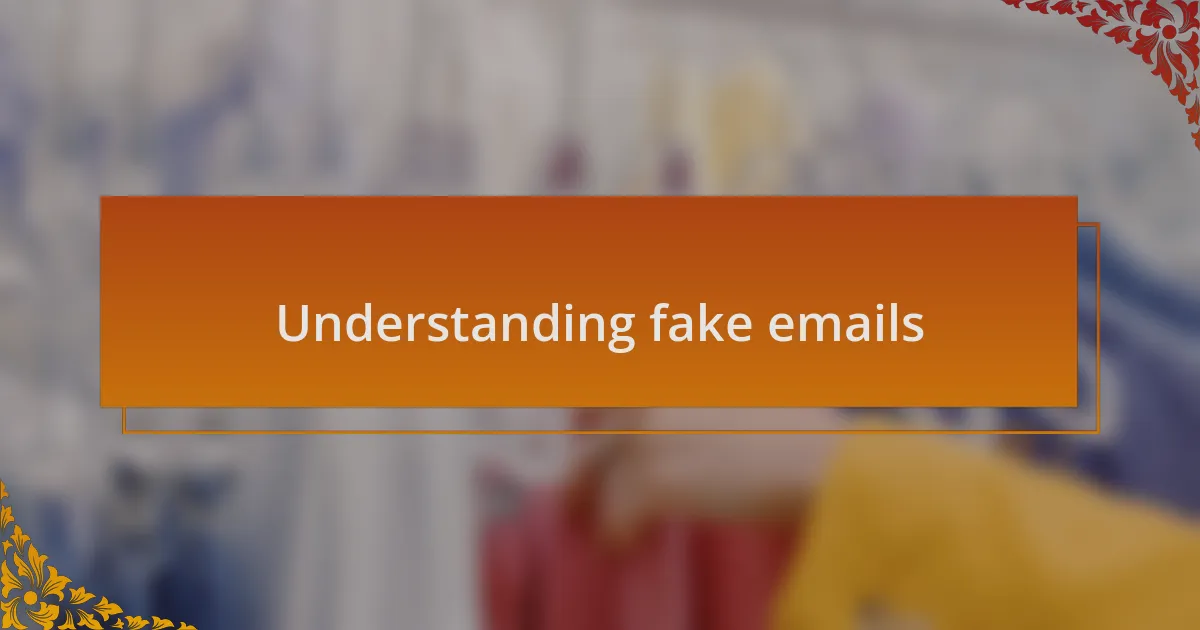
Understanding fake emails
Fake emails, often called phishing emails, are designed to deceive recipients into revealing sensitive information, like passwords or credit card numbers. I still remember the anxious moment when I received an urgent-looking email from what I thought was my bank. The message demanded immediate action, but a closer look revealed that something felt off. Have you ever stopped to wonder how easily one can be caught off guard by such impersonations?
These emails frequently adopt the look and feel of legitimate communication, making them especially tricky to identify. A friend of mine once almost fell for one that appeared to be from a popular online retailer offering a huge discount. The thrill of that deal was momentarily tempting, but it also made me realize how dangerous our desire for great offers can be. It’s crucial to pause and consider, could this email truly be authentic?
Understanding fake emails extends beyond just knowing they exist; it involves recognizing common traits such as poor grammar, generic greetings, or suspicious links. I often find myself examining every detail when I receive unexpected emails. It’s empowering to know that by being vigilant, I can safeguard my personal information and help others do the same. Don’t you think we all share a responsibility to stay informed and educate each other about these threats?
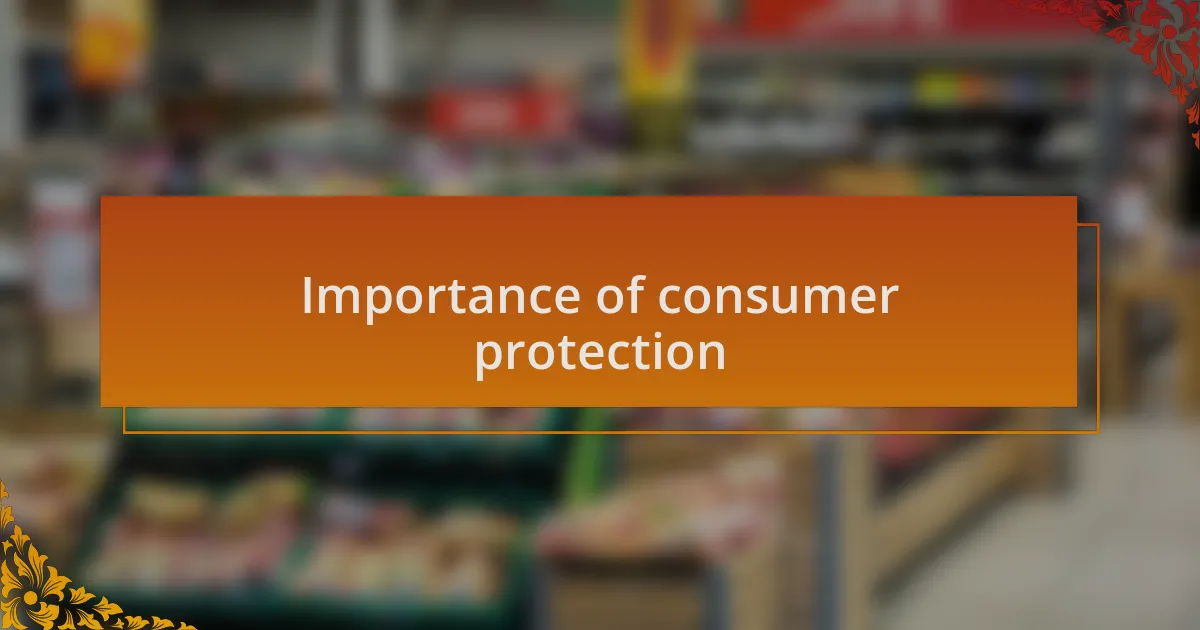
Importance of consumer protection
Consumer protection is essential because it fosters trust between businesses and consumers, ensuring that individuals can make purchases confidently. I often reflect on how many purchasing decisions are guided by the belief that if something goes wrong, there are mechanisms in place to rectify the situation. Without this trust, would we even feel secure sharing our financial information online?
Moreover, effective consumer protection policies help to create a fair marketplace. I still remember when my sister was unfairly charged for a service she never received, but thanks to robust regulations, she was able to reclaim her money. It’s a reminder of how these protections not only prevent fraud but also empower consumers to stand up for their rights. How can we enjoy the benefits of online shopping if we aren’t safeguarded from dishonest practices?
Ultimately, a robust consumer protection system not only minimizes risks but also educates consumers about their rights and responsibilities. I’ve participated in workshops that taught me how to identify my rights regarding online transactions, and this knowledge became an invaluable tool. Isn’t it amazing how understanding our rights can make us more confident and proactive consumers?
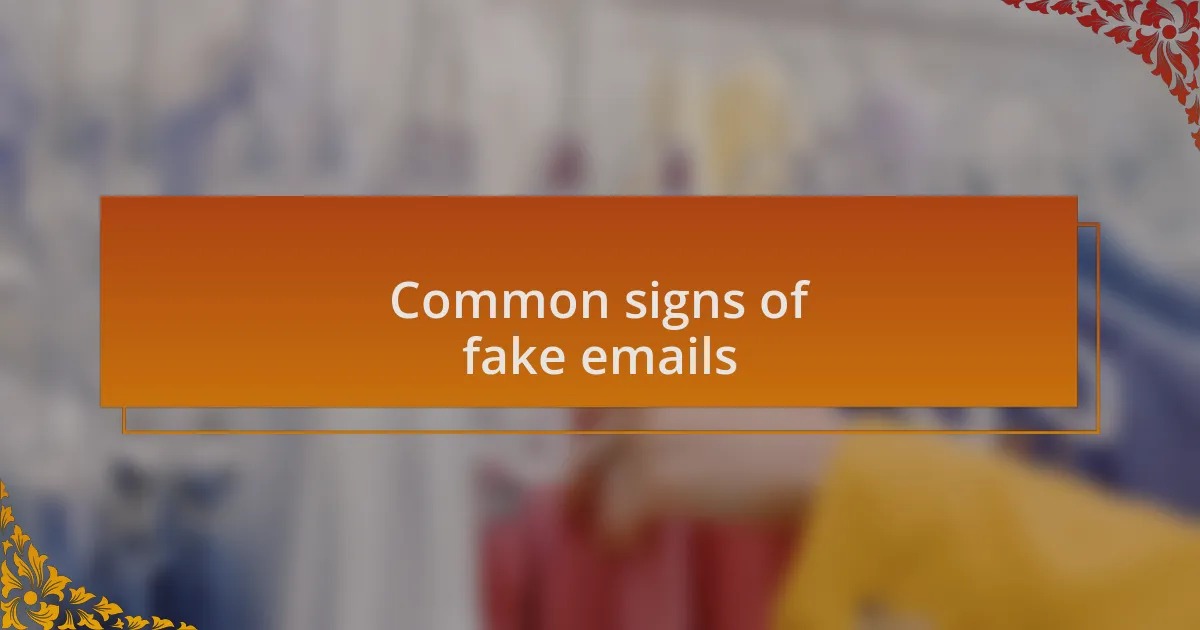
Common signs of fake emails
When it comes to spotting fake emails, one glaring red flag is often the sender’s address. I recall receiving a message that looked legitimate at first, but a closer look revealed that it came from a suspicious domain. It’s startling how a small discrepancy, like an extra letter or misspelled word in the email address, can indicate a possible scam. Have you ever paused to check if that familiar brand email is slightly off? Your intuition can save you from falling into a trap.
Another common sign is poor grammar and spelling. I still chuckle at a fake email I once got claiming to be from my bank, filled with typos and awkward phrasing. It seemed so odd coming from an institution that prided itself on professionalism. This made me wonder how many people overlook these mistakes in the urgency of the moment, missing out on a simple yet effective warning signal.
Lastly, the urgency in the language used can be a significant clue. I’ve received messages that demanded immediate action, creating a sense of panic as if my account was at risk. This tactic preys on our emotions—who hasn’t felt that rush of anxiety when prompted to act quickly? It’s worth pausing, taking a deep breath, and remembering that legitimate organizations usually don’t rush their communications. Would it hurt to take a moment to verify the authenticity of an email before responding? Absolutely not!
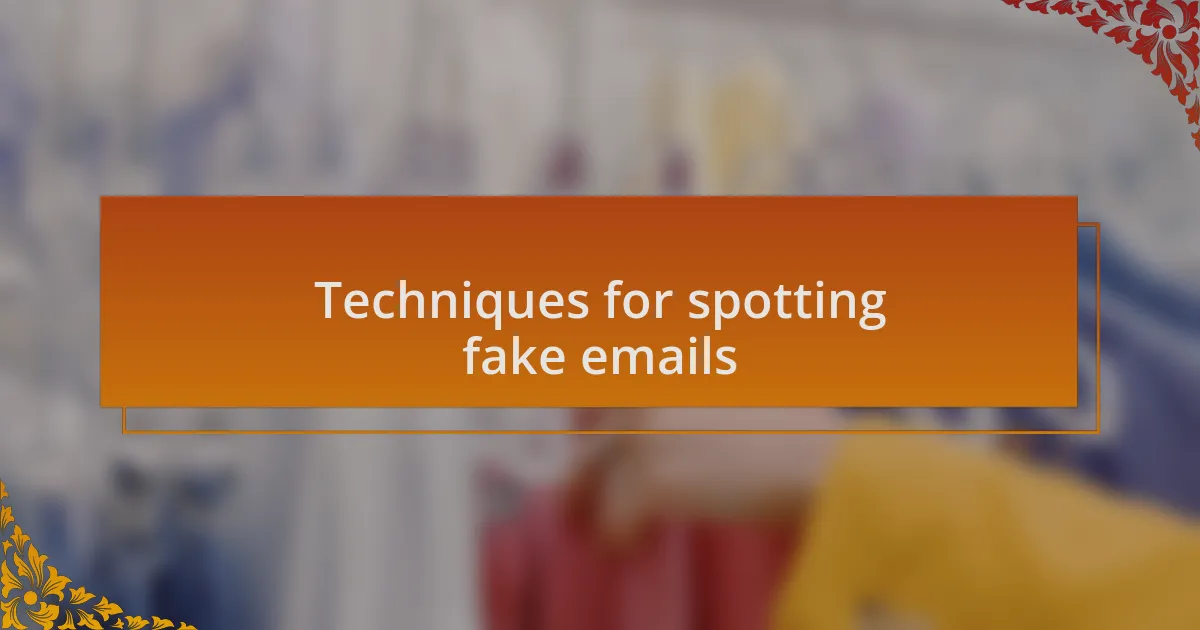
Techniques for spotting fake emails
When trying to identify fake emails, one technique that has served me well is examining the email’s content for inconsistency. I remember receiving a promotion that sounded amazing but seemed too good to be true. The message promised extravagant rewards, but the lack of a company logo and official branding made me suspicious. Have you ever felt that flutter of excitement only to second-guess the legitimacy? It’s always wise to match the content against what you know about the company.
Another technique I find useful involves checking for personalized greetings. Genuine emails from companies I trust usually address me by name, while scam emails often use generic salutations like “Dear Customer.” It’s fascinating how a simple detail can tell you a lot about the sender’s authenticity. I once opened a suspicious email that addressed me not as “John” but as “Valued Customer.” Immediately, my instincts kicked in—how could a company that claims to know me not bother to personalize their message?
Additionally, it’s imperative to hover over links before clicking. This might sound basic, but I often remind myself to take that extra second. Just last week, I nearly clicked on a link that directed me to what seemed like a login page for a popular service. Thankfully, a quick hover revealed a completely unrelated URL. When was the last time you inspected a link before clicking? That simple act can save you from a world of trouble.
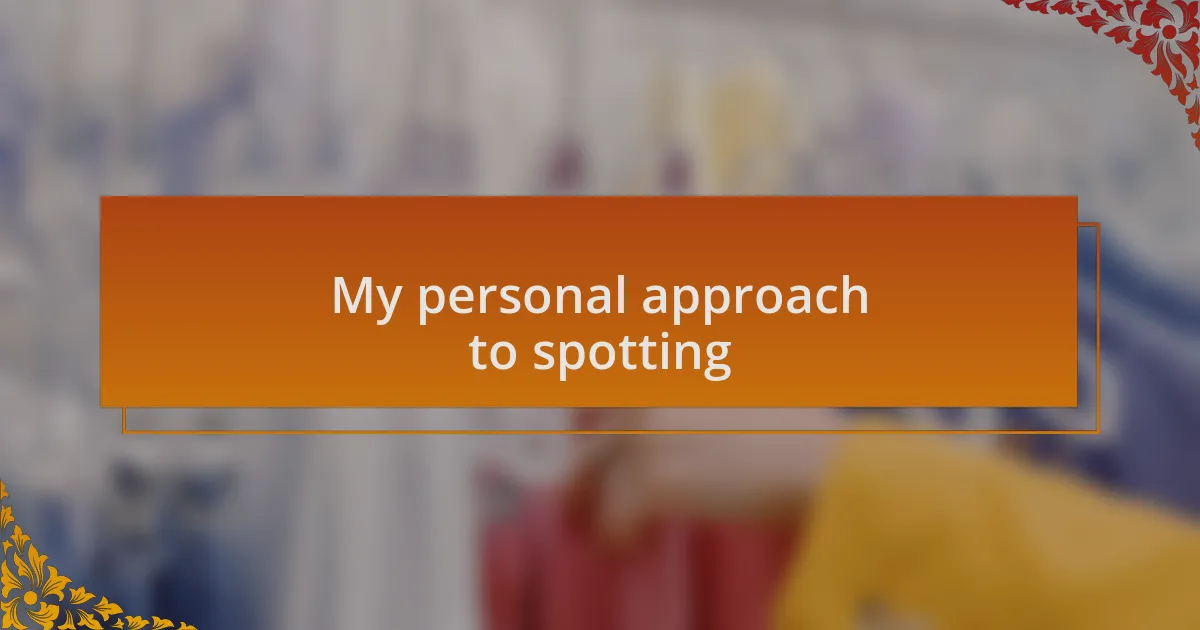
My personal approach to spotting
When it comes to spotting fake emails, I always scrutinize the sender’s address. There was a time when I received a seemingly urgent email from what appeared to be my bank, but the domain was a strange variation, like “bankservice123.com.” That moment made me stop and think—if it looks off, it probably is. Have you ever paused to examine the details of an email address? It’s amazing how a simple check can be a robust first line of defense.
I also pay close attention to the urgency or pressure conveyed in the email’s tone. I remember getting an email that prompted immediate action, threatening account suspension. This kind of alarmism isn’t typical for companies; they usually communicate so differently. It begs the question: Why did they insist on panicking me? That’s a big red flag in my book.
Moreover, I look for spelling and grammatical errors, as professional emails typically uphold a certain standard. I once encountered a message featuring glaring typos and awkward phrasing, which instantly raised my suspicions. Isn’t it odd how some scammers overlook the basics? I find it fascinating yet concerning that these small mistakes can often lead to bigger issues if overlooked.
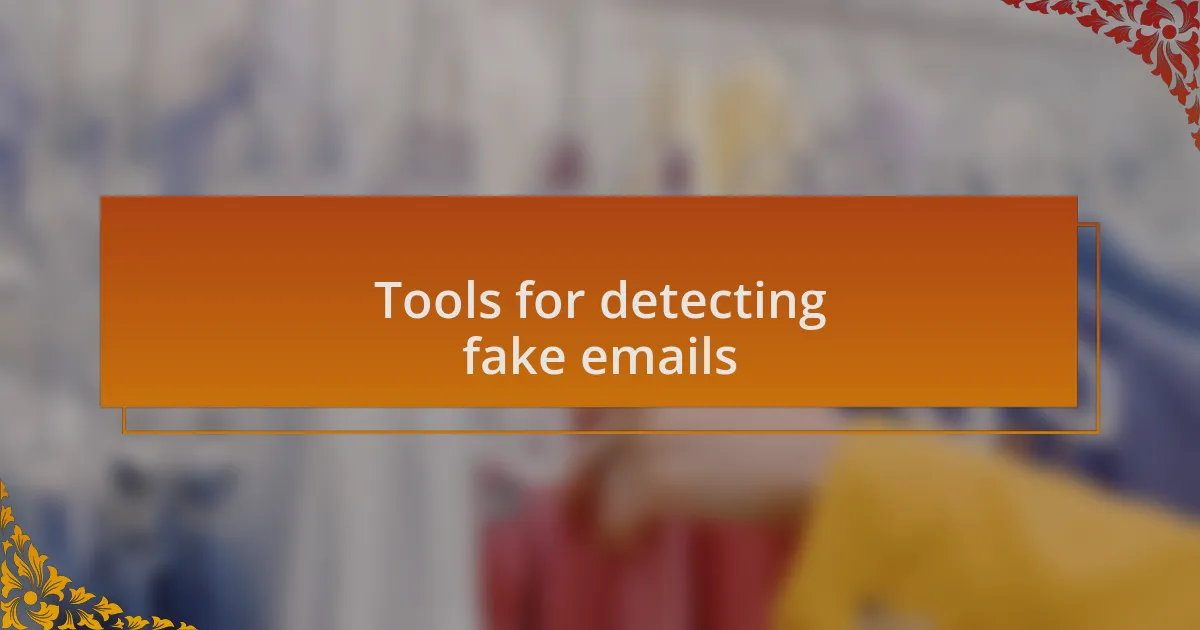
Tools for detecting fake emails
When it comes to tools for detecting fake emails, I’ve found that email verification services can be a huge help. For example, I use a tool that analyzes the sender’s email address for authenticity. One time, I was about to click a suspicious link when this tool flagged the sender as potentially fraudulent. That moment reminded me just how powerful technology can be in safeguarding my online interactions.
Spam filters are another essential tool in my defense arsenal. They automatically divert unwanted or questionable emails away from my main inbox, which I’ve noticed tends to reduce the number of potential threats I encounter. I recall feeling relieved when a filter caught a phishing attempt disguised as a package delivery notice. Wouldn’t you agree that having that extra layer of protection lets us breathe easier?
Furthermore, browser extensions that scan email links can also reveal whether a URL is safe or a trap. I once clicked a link in an email thinking it led to a legitimate site, but this extension highlighted that the URL had red flags. It made me realize how easily a moment of distraction could have led me down a risky path. Isn’t it reassuring to have tools that keep us alert and aware in the digital landscape?
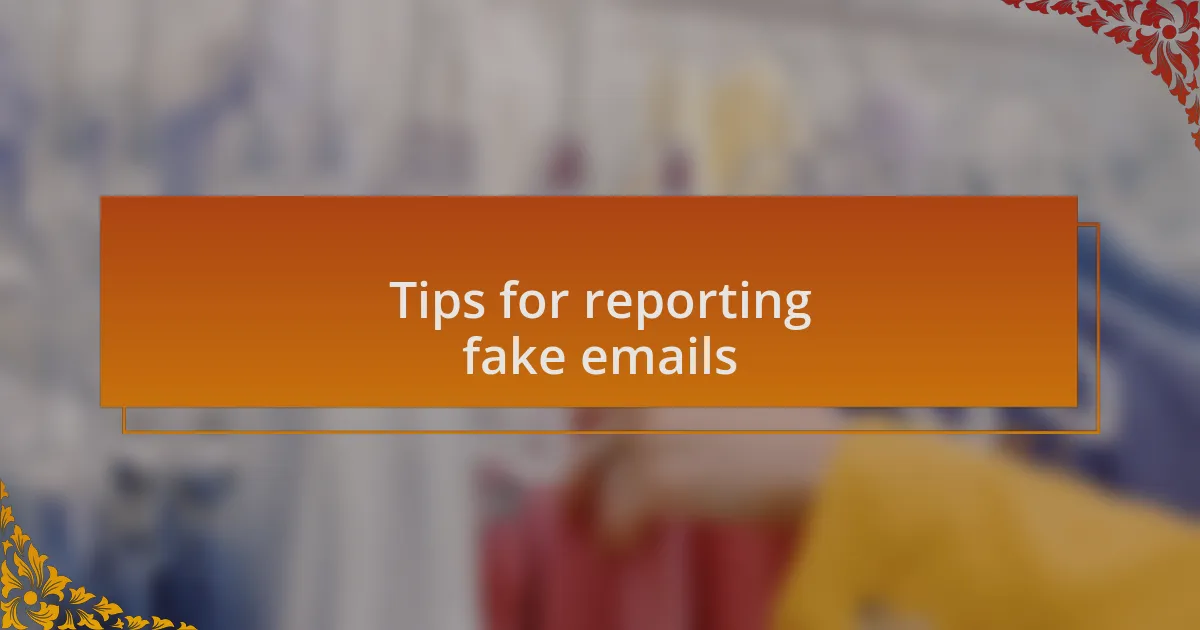
Tips for reporting fake emails
When I encounter a fake email, my first step is to report it directly to my email provider. Most platforms have a straightforward process, allowing users to flag suspicious messages easily. Just the other day, I reported one that tried to impersonate my bank. The sense of relief in knowing I contributed to preventing someone else’s potential loss was truly empowering.
It’s vital to provide as much detail as possible when reporting these emails. I make a habit of taking screenshots and noting key details, like the sender’s address and the content of the message. Sharing that information not only helps the provider address the issue better but also supports broader efforts in combating email fraud. Don’t you feel a bit more equipped when you can share crucial information?
Another resource I often use is government websites dedicated to consumer protection. They typically offer guidance on reporting scams and might even allow you to submit the email slightly more formally. The last time I did this, it struck me how interconnected we all are in this fight against fraud. Have you thought about how a single report can help protect countless others?